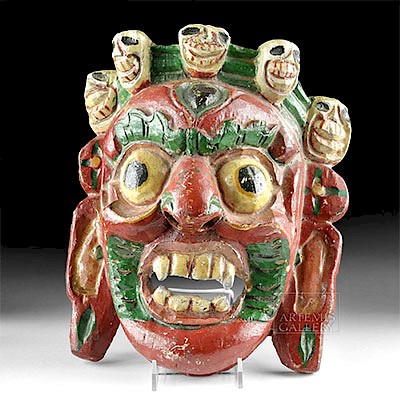Fine Chavin Brownware Stirrup Vessel - Conch Form
Lot 36
About Seller
Artemis Fine Arts
686 S Taylor Ave, Ste 106
Louisville, CO 80027
United States
Selling antiquities, ancient and ethnographic art online since 1993, Artemis Gallery specializes in Classical Antiquities (Egyptian, Greek, Roman, Near Eastern), Asian, Pre-Columbian, African / Tribal / Oceanographic art. Our extensive inventory includes pottery, stone, metal, wood, glass and textil...Read more
Estimate:
$2,200 - $3,300
Absentee vs Live bid
Two ways to bid:
- Leave a max absentee bid and the platform will bid on your behalf up to your maximum bid during the live auction.
- Bid live during the auction and your bids will be submitted real-time to the auctioneer.
Bid Increments
| Price | Bid Increment |
|---|---|
| $0 | $25 |
| $300 | $50 |
| $1,000 | $100 |
| $2,000 | $250 |
| $5,000 | $500 |
| $10,000 | $1,000 |
| $20,000 | $2,500 |
| $50,000 | $5,000 |
| $100,000 | $10,000 |
| $200,000 | $20,000 |
About Auction
By Artemis Fine Arts
Apr 25, 2019
Set Reminder
2019-04-25 10:00:00
2019-04-25 10:00:00
America/New_York
Bidsquare
Bidsquare : Pre-Columbian | Tribal | Ethnographic
https://www.bidsquare.com/auctions/artemis-gallery/pre-columbian-tribal-ethnographic-4035
Featuring ancient and ethnographic art from around the world, including Pre-Columbian, Native American, African / Tribal, Ethnographic, Spanish Colonial, Fossils, Fine Art, much more. Artemis Fine Arts info@artemisfinearts.com
Featuring ancient and ethnographic art from around the world, including Pre-Columbian, Native American, African / Tribal, Ethnographic, Spanish Colonial, Fossils, Fine Art, much more. Artemis Fine Arts info@artemisfinearts.com
- Lot Description
Pre-Columbian, North Coast Peru, Chongoyape, Tembladera phase, ca. 1200 to 1000 BCE. A fabulous mold-formed brownware pottery bottle with a flat base, a bulbous ovoid body, a wide stirrup-shaped handle, and a cylindrical spout with an everted lip. The body of the highly-burnished vessel depicts a large conch shell of a stylized form with coiled points projecting laterally on either end. The top shell layer is incised with intricate curvilinear striations, perhaps symbolizing the head and interior body of the animal itself, and each detail is liberally rubbed with vivid red cinnabar. Shell effigy vessels would have been used in ceremonial or ritual contexts, as many ancient Peruvian cultures featured conch shells in creation myths. Size: 6.875" W x 8.375" H (17.5 cm x 21.3 cm).
The stirrup vessel form is named for the stirrup for horseback riding. In addition to being iconographically rich, these vessels were also practical. Their narrow openings prevented rapid evaporation of the precious liquid within - a great advantage given the extremely dry deserts of Peru. Note also that the shape of the neck made it easy to carry. Two stirrup vessels could be tied to the ends of a cord and suspended over a llama's back or a person's shoulder.
The Chavin civilization is generally regarded as the Andean mother civilization - oftentimes compared to the Olmec of Mexico. Both the Chavin and the Olmec cultures created the earliest Pre-Columbian visual culture that continued to flourish until European contact in the 16th century. Using molds and modeling the forms by hand, the Chavin made numerous stirrup-spout vessels like this example. Scholars have suggested that the indigenous used them to store fermented corn beer or "chicha".
For an example with stylistically-similar incised details, please see: Clifford, Paul A., Elizabeth P. Benson, and Lois Katz, et al. "Art of the Andes: Pre-Columbian Sculptured and Painted Ceramics from the Arthur M. Sackler Collections." The Arthur M. Sackler Foundation and The AMS Foundation for the Arts, Sciences and Humanities. Washington, D.C., 1983, p. 57, fig. 20b.
Provenance: private Colorado, USA collection; ex-Tom Browner collection, Ohio, USA, acquired at auction
All items legal to buy/sell under U.S. Statute covering cultural patrimony Code 2600, CHAPTER 14, and are guaranteed to be as described or your money back.
A Certificate of Authenticity will accompany all winning bids.
We ship worldwide and handle all shipping in-house for your convenience.
#143769Minor abrasions to body, handle, spout, and base, with light softening to some finer details, fading to areas of red cinnabar, light encrustations within some recessed areas, and stable hairline fissures around base of one side of handle, otherwise intact and excellent. Light earthen deposits and great traces of original cinnabar throughout.Condition
- Shipping Info
-
All shipping is handled in-house for your convenience. Your invoice from Artemis Gallery will include shipping calculation instructions. If in doubt, please inquire BEFORE bidding for estimated shipping costs for individual items.
-
- Buyer's Premium



 EUR
EUR CAD
CAD AUD
AUD GBP
GBP MXN
MXN HKD
HKD CNY
CNY MYR
MYR SEK
SEK SGD
SGD CHF
CHF THB
THB

















